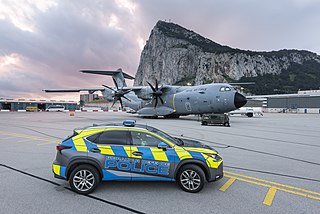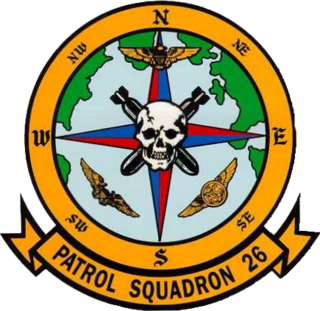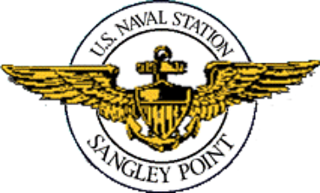
Cam Ranh Bay is a deep-water bay in Vietnam in Khánh Hòa Province. It is located at an inlet of the South China Sea situated on the southeastern coast of Vietnam, between Phan Rang and Nha Trang, approximately 290 kilometers northeast of Ho Chi Minh City.

Kenitra is a city in north western Morocco, formerly known as Port Lyautey from 1932 to 1956. It is a port on the Sebou river, has a population in 2014 of 431,282, is one of the three main cities of the Rabat-Salé-Kénitra region and the capital of the Kenitra Province. During the Cold War Kenitra's U.S. Naval Air Facility served as a stopping point in North Africa.

RAF Gibraltar is a Royal Air Force station on Gibraltar. No military aircraft are currently stationed there, but RAF, Commonwealth and aircraft of other NATO nations will periodically arrive for transient stopovers, exercises, or other temporary duty. Administered by British Forces Gibraltar, the station is a joint civil-military facility that also functions as the Rock's civilian airport – Gibraltar Airport, with the civilian airport's passenger terminal building and apron facilities located on the north side of the runway while the apron and hangar of RAF Gibraltar are located on the south side of the runway.

A naval air station is a military air base, and consists of a permanent land-based operations locations for the military aviation division of the relevant branch of a navy. These bases are typically populated by squadrons, groups or wings, their various support commands, and other tenant commands.

Naval Station Argentia is a former base of the United States Navy that operated from 1941 to 1994. It was established in the community of Argentia in what was then the Dominion of Newfoundland, which later became the tenth Canadian province, Newfoundland and Labrador.

Gharb-Chrarda-Béni Hssen was formerly one of the sixteen regions of Morocco from 1997 to 2015. It was situated in north-western Morocco, covers an area of 8,805 square kilometres (3,400 sq mi) and has a population of 1,904,112. The capital was Kenitra.

Naval Air Station South Weymouth was an operational United States Navy airfield from 1942 to 1997 in South Weymouth, Massachusetts. It was first established as a regular Navy blimp base during World War II. During the postwar era the base became part of the Naval Air Reserve Training Command, hosting a variety of Navy and Marine Corps reserve aircraft squadrons and other types of reserve units. Like most BRAC sites, environmental contamination was detected in 1986, and since 1993 numerous remedies and long term monitoring of ground water are in place. Since 2005, over 600 acres have been transferred to the affected towns for reuse, and in 2011 the Navy signed a $25 million contract to transfer its remaining land.

The VP-26 Tridents are a United States Navy aircraft squadron based at Naval Air Station Jacksonville in Florida. The squadron flies Boeing P-8A patrol aircraft. It was established as Bombing Squadron 114 (VB-114) on 26 August 1943 and renamed Patrol Bombing Squadron 114 (VPB-114) on 1 October 1944; Patrol Squadron 114 (VP-114) on 15 May 1946; Heavy Patrol Squadron (Landplane) 6 (VP-HL-6) on 15 November 1946, and Patrol Squadron 26 (VP-26) on 1 September 1948. The Tridents are the third squadron to be designated VP-26; the first VP-26 was renamed VP-102 on 16 December 1940, and the second VP-26 was renamed VP-14 on 1 July 1941.
Kenitra Air Base is a military airport in Kenitra, a city in the Rabat-Salé-Kénitra region in Morocco. It is also known as the Third Royal Air Force Base, operated by the Royal Moroccan Air Force.

Naval Air Station Port Lyautey is a former United States Navy Naval Air Station in Morocco, about 5 kilometres (3.1 mi) north-northwest of Kenitra and about 120 kilometres (75 mi) northeast of Casablanca. The Naval Air Station was turned over to the Royal Moroccan Air Force and the last of US military personnel departed the base in 1977. The airport was later reopened as Kenitra Airport after it was closed.

Naval Station Sangley Point was a communication and hospital facility of the United States Navy which occupied the northern portion of the Cavite City peninsula and is surrounded by Manila Bay, approximately eight miles southwest of Manila, the Philippines. The station was a part of the Cavite Navy Yard across the peninsula. The naval station had a runway that was built after World War II, which was used by U.S. Navy Lockheed P-2 Neptune, Lockheed P-3 Orion, and Martin P4M Mercator maritime patrol and anti-submarine warfare aircraft. An adjacent seaplane runway, ramp area and seaplane tender berths also supported Martin P5M Marlin maritime patrol aircraft until that type's retirement from active naval service in the late 1960s. NAS Sangley Point/NAVSTA Sangley Point was also used extensively during the Vietnam War, primarily for U.S. Navy patrol squadrons forward deployed from the United States on six-month rotations. The naval station was turned over to the Philippine government in 1971. It is now operated by the Philippine Air Force and Philippine Navy.
Sidi Yahya El Gharb is a town in Sidi Slimane Province, Rabat-Salé-Kénitra, Morocco. According to the 2004 census it has a population of 31,705.
Sidi Slimane Air Base was a military air base in Sidi Slimane, a city in the Rabat-Salé-Kénitra region in Morocco. It is also known as the Fifth Royal Air Force Base, operated by the Royal Moroccan Air Force.

Naval Air Station Tongue Point is a former United States Navy air station which was located within the former U.S. Naval Station Tongue Point, Astoria, Oregon.
Kceibya is a small town and rural commune in Sidi Slimane Province, Rabat-Salé-Kénitra, Morocco. At the time of the 2004 census, the commune had a total population of 23,218 people living in 3295 households. It lies along the road from Sidi Yahya El Gharb to Sidi Slimane.
Oulad H'Cine is a small town and rural commune in Sidi Slimane Province, Rabat-Salé-Kénitra, Morocco. At the time of the 2004 census, the commune had a total population of 27,972 people living in 4389 households.
The United States Navy proposed to the U.S. Congress the development of a lighter-than-air station program for anti-submarine patrolling of the coast and harbors. This program proposed, in addition to the expansion at Naval Air Station and Lakehurst, the construction of new stations. The original contract was for steel hangars, 960 ft (290 m) long, 328 ft (100 m) wide and 190 ft (58 m) high, helium storage and service, barracks for 228 men, a power plant, landing mat, and a mobile mooring mast.

US Naval Advance Bases were built globally by the United States Navy during World War II to support and project U.S. naval operations world-wide. A few were built on allied soil, but most were captured enemy facilities or completely new. Advance bases provided the fleet with support to keep ships tactically available with repair and supply depots of facilities, rather than return them to continental United States. Before Japan declared war on the United States the US Navy had a single fleet sized advanced base in the Territory of Hawaii. It was Naval Station Pearl Harbor. During the war the US Navy Seabees built over 400 advance bases categorized by size. Naval bases were either Lions or Cubs while airfields were either Oaks or Acorns. Lions and Oaks were major facilities while Cubs and Acorns were minor. PT Boats typically would get a Cub and airfields with single runways were Acorns. The larger bases could do refueling and overhaul; loading of troopship and cargo ships; and preparing amphibious assault ships. Some became major repair depots. The Seabees developed auxiliary floating drydocks were able to repair battle damage and do regular maintenance in the field saving ships trans-pacific trips for repair. A few bases also were developed to be R and R for all U.S. personnel. Most Advance Bases were built by the US Navy's Seabees in Naval Construction Battalions (CBs). At the start of the war some civilian contractor were employed in construction. The Seabees in World War II built most of the airfields used by the United States Army Air Forces and United States Marine Corps, as they had the ships and cranes needed to transport the vast amount of equipment needed at the advance bases. The US Army and United States Coast Guard also operated out of many of these facilities. Seabees could build new or repair damaged runways, and with advancements in heavy bomber technology lengthen runways as needed. A few Naval Advance Bases were built for the Korean War and Vietnam War.












